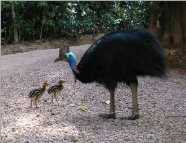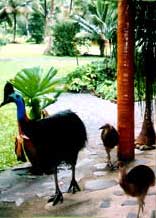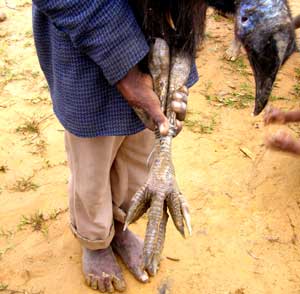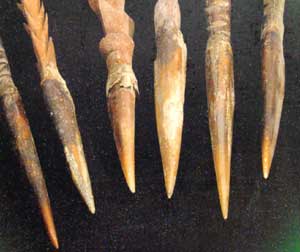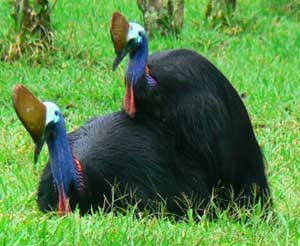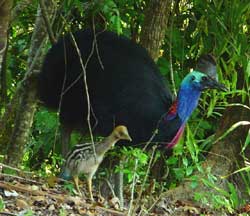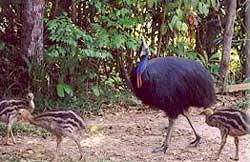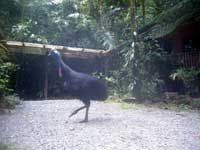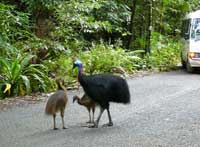 Accommodation | International
Flights | Domestic
Flights | Tours
| Travel
Insurance | Car
Hire | Visas
| Shopping
| Dating
| Humour
Accommodation | International
Flights | Domestic
Flights | Tours
| Travel
Insurance | Car
Hire | Visas
| Shopping
| Dating
| HumourCassowary
Australia's most spectacular bird would have to be the cassowary, up to two metres tall, covered in coarse black double stranded feathers, and with brilliant colors of red and blue on its neck and head. This elusive flightless bird is highly endangered and lives only in the Wet Tropics area of North Queensland, another patch of remote rainforest high up on the Cape York peninsula, and New Guinea. The cassowary (Casuarius casuarius johnsonii) has been wandering around this planet since before the super continent Gondwana broke up in to several continents, and they have relatives in several distant continents. They belong to a family of birds called ratites and are related to the Emu, the Ostrich, the Kiwi (though there is a dramatic difference in size) and the South American Rhea - a little known bird that resembles a small emu and runs around plains in Patagonia. They are also related to the now extinct Moas of New Zealand and the Elephant Bird of Madagascar. In New Guinea there are two other species of cassowary too but in Australia the only species is the Southern Cassowary.
If you stay in accommodation in the Daintree rainforest you have a good chance of meeting one of these birds.
Cassowaries growing up
Cassowaries (genus Casuarius) are frugivorous; fallen fruit and
fruit on low branches is the mainstay of their diet. They also
eat fungi, insects, frogs, spiders, snakes and other small animals,
even dead ones and roadkills. They live for about 40-50 years.
They are the second-largest bird in Australia and the third-largest
remaining bird in the world (the ostrich and emu are larger).
The name cassowary is of Papuan origin, from "kasu"
- horned and "weri' - head
The birds grow to 1.5 - 1.8 m tall, though the females are larger and can reach 2 m and they weigh about 60 kilograms, but the heaviest recorded was 83kg. They have a bony casque on the head that is used to batter through underbrush, this is made of keratin, the same material as our nails and hair. The casque is also used for headbutting and some people believe it is used to receive the very low frequency humming noise that they can make.
|
|
Usually cassowaries are very shy but when they feel threatened or want to protect their young they can lash out dangerously with their powerful legs and jump and kick with both legs at once. Their three-toed feet have sharp claws; the dagger-like middle claw is 12 cm long.
|
|
Cassowaries are very capable of killing dogs by disemboweling them and have injured people, though only one death has been recorded, more on this on the cassowary attacks page. They can run up to 50 km/h and jump up to 1.5 m. They are also good swimmers and have been observed swimming across the channel from Cardwell to Hinchinbrook Island.
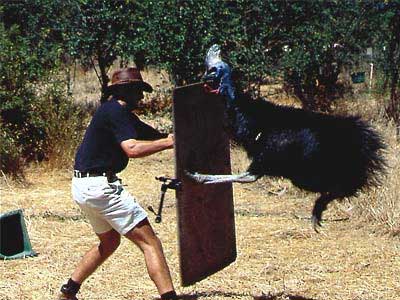
Cassowary attacking
Contributor unknown
They don't have much of a family life, they are solitary birds but females will cruise around the forest mating with several males during the breeding season from May to November. Courtship is initiated by the male when a female enters his territory. The smaller sized male must approach the larger female with caution because if she is not in the mood she is capable of seriously injuring him. The male begins courtship by circling around the female and making a low rumbling sound.
|
Two mating cassowaries at the Mission Beach Sanctuary |
When she has laid her eggs, three to eight, measuring about 90 by 140 mm and pale green-blue in color, in a shallow scrape in the ground in which the male has placed leaves and grass, she moves on again to repeat the process with another male. It is the male's duty to incubate the eggs for about fifty days and also to care for the chicks for another year or so. The chicks are striped until they are about 6-9 months old and become a glossy black colour when they are about 3 years old. By that time, the skin on the neck and head begins to turn color, and the casque begins to develop. Cassowaries are capable of breeding when they are three years old.
|
Cassowaries are crucial to the survival of the rainforest, as many of the seeds are too big to be dispersed by any other birds. The cassowary eats about 150 different ones. Cassowaries swallow fruit whole and then excrete intact fruit seeds in large piles of dung which acts as a ready-made fertiliser, the dung helps the seed to grow. White-tailed rats, bush rats, melomys and musky rat-kangaroos sometimes feast on seeds in cassowary droppings. But most seeds survive to germinate. Usually, seeds are deposited within a kilometre of where they were eaten.
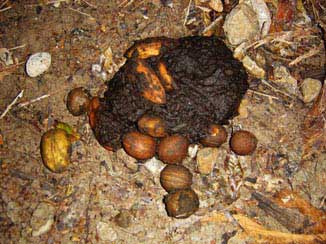
Cassowary droppings.
Photo by Cooper Creek
Wilderness
Aborigines used to hunt and eat cassowaries. The hunters used a short
pipe like a mini digeridoo and by hitting their hand on one hand
of the pipe they made a sound that attracted or confused the cassowaries,
the birds were also easy to find as they usually have a routine
and walk the same route everyday.
The meat of the cassowary is said to be very strong in taste and
to even make some people a bit dizzy the first time they eat it.
Cassowaries are still part of the diet in New Guinea, where they
are either hunted or kept as domestic animals, though this is
risky as the birds can escape and if it injures or kills anyone
in the village family members will expect compensation or a revenge
killing.
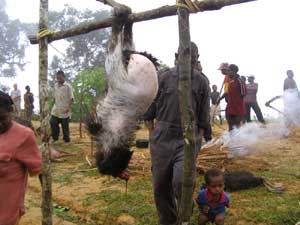
Photo by Craig Campbell
Cassowary being cooked in New Guinea village
The total population of cassowaries in Australia is estimated to be around the 1500, they are endangered and declared a protected species. The main problems for them are;
- loss of habitat through clearing for
residential settlement and agricultural expansion (nowadays
everyone thinks the rainforest starts at the DaIntree river,
it used to start hundreds of kilometres further south before
the introduction of sugarcane)
- fragmentation of habitat ( from roads,
farms and subdivisions)
- vehicle traffic (road kills are the number
one cause of adult cassowary deaths, especially around the
Mission Beach area),
- dogs (which are especially aggressive to
chicks and juveniles)
- feral pigs - they compete for food with
cassowaries and chew the seeds so they will not be dispersed
and germinated like when they pass through a cassowary
- Some birds are still being shot and eaten
up Cape York
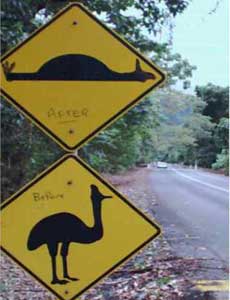
Photo by Rob Lapaer of Rainforest
Hideaway B&B, Cape Tribulation, N.Qld.
This 'before and after' bit of artwork is situated along the
road to Cape Tribulation.
It’s best not to stop if you see a Cassowary on the road, but to slow down instead. This is to prevent encouragement of the bird’s interest in cars and to reduce its risk of being hit or causing an accident.
Do not feed a Cassowary as this reinforces its interest in people and contributes to its fearless attitude.
|
|
Cassowary having a drink |
It must be mating season, |
This cassowary casually cruises in for a visit |
Cassowary and chicks |
When driving near a Cassowary, move away quickly so the bird will become disinterested.


Southern Cassowary (Casuarius Casuarius)., Daintree NP, Queensland,
Australia
Buy
this Photographic Print at AllPosters.com
Some cassowary videos...
For more photos and some short movies of this magnificent bird see the photo gallery of Cape Tribulation Rainforest Hideaway B&B
Where can you see this bird?
They only live roughly from Mission beach to
just north of Cape Tribulation and inland as far as the Atherton
Tablelands.
You may encounter them on the roads in these areas so keep
your speed down but do not stop and definitely do not feed
them.
Some accommodation places to stay where
you have a reasonable chance of seeing them;
HOME PAGE
Tourist Information
General Information
And Entertainment
ACCOMMODATION IN AUSTRALIA
Bed
& Breakfast
Budget
Accommodation
Backpackers Hostels
Hotels
in Australia
CAR HIRE IN AUSTRALIA
Australia Rental Cars
And
Campervans

TOURS
IN AUSTRALIA
What To Do In Australia
On-line
Shopping
On-line
Dating
![]()
About
Australia
Visas For Australia
How
To Get To Australia
How To Get Around
Travel Insurance
Travel Guides
Working
In Australia
Australian
Posters
Survival
Tips
Weather,
When To Go

Use of
this website constitutes acceptance of the User Agreement for this website
Contact us |
Advertise on this site
| Link to this site |Add
your photos or stories to this site |
Webmasters | Affiliates
